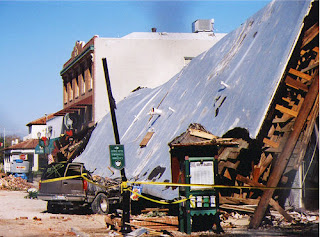Having lived in California
 |
| Mission LaPurisima |
Lompoc -1927, 5.49 a.m. (7.1) No Deaths: This earthquake, located about 10 miles offshore produced a sea-quake so violent it killed and stunned fish near Point Arguello and shook two ships in the area. No serious damage.
 |
| Downtown Paso Robles |
Paso Robles - 2003, 11:15 a.m. (6.5), Two Deaths. On December 22nd, 25 miles North-West of Paso Robles, actually near San Simeon, the earth shook. The damage was centered in downtown Paso Robles and caused two deaths when the roof slid off the clock tower building. The dormant underground sulfur springs ripped open causing flooding and a large sinkhole in the parking lot of the city hall, not to mention the town reeked of the smell of sulfur for months. Paso Robles dedicated a new clock tower in memory of the two women who died.
 |
| State Street |
Architect Julia Morgan (Hearst Castle , Asilomar) was in Santa Barbara
Had the quake struck later in the morning as people were on their way to work the death toll would have been higher. Unlike the 1906San Francisco quake, Santa Barbara
Had the quake struck later in the morning as people were on their way to work the death toll would have been higher. Unlike the 1906
 |
| The Santa Barbara Mission |
If you are Inside: Take cover by getting under a sturdy piece of furniture and wait until the shaking stops. If there isn’t a table or desk near you, cover your face and head with your arms and crouch in an inside corner where the building supports are the greatest. Freestanding walls fall easily. Stay away from glass, windows, anything that could fall, such as lighting fixtures. Use a doorway for shelter only if it’s in close proximity, and if you know it’s a load bearing doorway. Stay inside until the shaking stops. Research shows that most injuries occur when people inside buildings attempt to move to a different location. Be aware that the electricity may go out or the sprinkler systems or fire alarms may turn on, or that a gas pipe might have broken. Never use the elevators!
If you are Outside: Stay there and move away from buildings, streetlights, and utility wires and wait until the shaking stops. The greatest danger exists directly outside of buildings. Many of the 120 fatalities from the 1933 Long Beach
If you’re Driving: Stop as quickly as safety permits and stay in the vehicle. Avoid stopping near or under buildings, trees, overpasses, and utility wires. Proceed cautiously once the earthquake has stopped. Avoid roads, bridges, or ramps that might have been damaged.

No comments:
Post a Comment